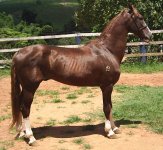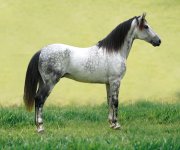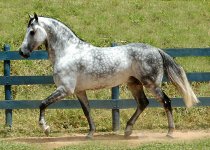♘امیرحسین♞
♘ مدیریت انجمن اسب ایران ♞
The Mangalarga Marchador is a breed of horse. Highly regarded as the National Horse, there are over 350,000 registered Mangalarga Marchador horses in Brazil and a number found in several countries outside its Brazilian homeland. As an Iberian breed, descending from the Andalusian horse stallions of Portugal and barb mares, they have carriage, beauty and intelligence, a warm personality and are easily trained for almost any discipline. The Marchador horses are known for having a smooth stable walk, canter and gallop as well as a natural diagonal (batida) or lateral (picada) four beat gait with a brief moment of triple hoof support. Their endurance, versatility out on the range, trail and pleasure riding as well as the ability to be trained in dressage or jump, makes the batida Mangalarga Marchador a wonderful sport horse that can be inspected and registered as a warmblood.
History
The beginning
It all began when Francisco Gabriel Junqueira (Baron of Alfenas) decided to start a breeding study mixing his Royal Alter stallions with the common horse stock he had in his farm by that time. The common stock was a mix of Barb horses (mostly) and other breeds that came to Brazil by the time of its colonization. The result of the Alter x colonial horse cross mix was a much beautiful horse with a smooth gait. The Baron called these horses Sublimes.
The time passed and Francisco Junqueira sold some of the Sublimes to his friend, who had a farm in Paty do Alferes in Rio de Janeiro state. The farm name was Mangalarga, and his owner sarted to use the Sublime horses to go to the Imperial capital, the Rio de Janeiro City. In Rio, people took notice of the smooth good looking Sublimes and started to call them Mangalargas.
There is a consensus among breeders and researchers about the history of the Baron of Alfenas, such as divulged in many publications since Imperial times. There is also consensus that up to 1910 most of the ranchers involved in the development of the breed (especially the members of the Junqueira family followed his recommendations of evolution with the fixation of the marching gait, rusticity, resistance and good temper.
The breed Split
In 1934 the Mangalarga Breeders Association was created. The founders had very clear and even obvious motivations, such as to define the directions of the breeding efforts, the function and the use of the horses, the desired characteristics of individuals in their functional and morphologic aspects, and a very clear definition of the intended gait. Those facts are very well documented, officially or otherwise, in constitution writs, stories told by ranchers of those times and even novels about the breed.
The founders of that association had already used other breeds to achieve their objectives since they moved from Minas Gerais to São Paulo state. They had made use of many trotting breeds (Arabs, Anglo-Arabian, English Thoroughbred, Morgan, Lusitan, Trakehner, American Saddlebred, American Trotter), and traction horses (Hackney) - with special attention to the use of the latter as a means of fixing the elevated movement. Theses mixes were made as a tentative to morphologically adapt the original Mangalarga to the "paulista" topography and culture.
Because of this situation there was an increase in the differences between breeders that wanted to maintain the original objectives and those that defended the miscegenation. The Mangalarga Breeders Association closed its Stud Books in 1943, about 9 years after its foundation.
So a group of breeders that disagreed from the objectives of the 1934 Association (Mangalarga) met in 1948 to found the Association (Mangalarga Marchador) that became today's ABCCMM.
In order to unite political force to create a new Stud Book, the breeders counted on the political prestige and technical expertise of professor Geraldo Carneiro. Dr. Geraldo, veterinarian and zootechnist, was a friend and neighbor of the governor of Minas Gerais and future president of Brazil, Juscelino Kubitschek. With those qualifications and contacts he succeeded in adding up a formula that permitted the preservation of the Original Marchador Horse, by means of founding a new association. With sufficient backing, there was a meeting called by a group of breeders in Hotel Gloria, in the city of Caxambu. Among those present was Dr. Joaquim Fernandes Braga, superintendent of the Animal Production Department of the state of Minas Gerais, Secretary of Agriculture, Industry, Trade and Labor. There were also graduated personnel from the same Secretary and from the federal Ministry of Agriculture, making clear the interest and focus demonstrated by higher authorities. In this preliminary reunion the Writs of Intention were signed by public workers, technicians and breeders, in total 22 persons.
The Breed Today
With more than 350,000 horses registered the Brazilian Mangalarga Marchador National Association (ABCCMM) is the biggest registry office of any type in Minas Gerais state. While there are less than two hundred foundation Mangalarga Marchador horses in the United States, they are catching the attention of the horse world. You may have seen them on Horse Talk TV, marching in the New Year’s 2002 Tournament of Roses Parade, at Fiesta of the Spanish Horse, Western States Horse Expo in Sacramento, Equine Affaire in Pomona, Southern National Exposition in Perry, Georgia or Equitana in Lexington, Kentucky. There are breeders and owners in many states: Arizona, California, Colorado, Florida, Georgia, Michigan, Montana, Ohio, Tennessee, West Virginia and Wyoming.
Breed Characteristics
Type
Middle size, agile, strong structures and well proportionate, vigorous and healthy, visually light expression in the appearance, fine and smooth skin, fine, smooth and silky furry, active and docile temperament.
Height
For males ideal is of 1,52m, when there are admitted for the definite register at least 1,47m and maxim of 1,57m. For females ideal is of 1,46m, when there are admitted for the definite register at least 1,40m and maxim of 1,54m.
Head
* Shape: triangular, well outlined, middle and harmonious, wide and flat forehead;
* Profile: right-lined in the forehead and of sub-concave right-lined one in I chamfer it;
* Eyes: remote and expressive, big, prominent, dark and living creatures, fine and flexible eyelids;
* Ears: averages, movable, parallel, quite introduced, directed up, of preference with the tips lightly turned for inside;
* Throat: it sets sail and quite definite;
* Mouth: of middle opening, fine, movable and firm lips;
* Nostrils: big, quite open and flexible;
* Throat Latch: wide and skinny.
Neck
Pyramidal shape, light form in general, proportional appearance, oblique, with strong musculature, presenting balance and flexibility, with harmonious insertions, being that of the body in the superior third of the chest. When light convexity is admitted, in males, in the dorsal edge - as expression of sexual secondary character - thinning, fine and silky manes.
The Gait
Gaited, symmetrical progress, at four times, with alternate support of the bipeds side and diagonal, always inserted by moments of triple hoof support.
Ideal characteristics: regular, elastic, with incident of overfootprint or ultrastuck, always balanced, with progress in diagonal and times of support of the diagonal bipeds bigger side than lateral, discreet movement of arms, describing seen semicircle of profile, good flexibility of articulations.
History
The beginning
It all began when Francisco Gabriel Junqueira (Baron of Alfenas) decided to start a breeding study mixing his Royal Alter stallions with the common horse stock he had in his farm by that time. The common stock was a mix of Barb horses (mostly) and other breeds that came to Brazil by the time of its colonization. The result of the Alter x colonial horse cross mix was a much beautiful horse with a smooth gait. The Baron called these horses Sublimes.
The time passed and Francisco Junqueira sold some of the Sublimes to his friend, who had a farm in Paty do Alferes in Rio de Janeiro state. The farm name was Mangalarga, and his owner sarted to use the Sublime horses to go to the Imperial capital, the Rio de Janeiro City. In Rio, people took notice of the smooth good looking Sublimes and started to call them Mangalargas.
There is a consensus among breeders and researchers about the history of the Baron of Alfenas, such as divulged in many publications since Imperial times. There is also consensus that up to 1910 most of the ranchers involved in the development of the breed (especially the members of the Junqueira family followed his recommendations of evolution with the fixation of the marching gait, rusticity, resistance and good temper.
The breed Split
In 1934 the Mangalarga Breeders Association was created. The founders had very clear and even obvious motivations, such as to define the directions of the breeding efforts, the function and the use of the horses, the desired characteristics of individuals in their functional and morphologic aspects, and a very clear definition of the intended gait. Those facts are very well documented, officially or otherwise, in constitution writs, stories told by ranchers of those times and even novels about the breed.
The founders of that association had already used other breeds to achieve their objectives since they moved from Minas Gerais to São Paulo state. They had made use of many trotting breeds (Arabs, Anglo-Arabian, English Thoroughbred, Morgan, Lusitan, Trakehner, American Saddlebred, American Trotter), and traction horses (Hackney) - with special attention to the use of the latter as a means of fixing the elevated movement. Theses mixes were made as a tentative to morphologically adapt the original Mangalarga to the "paulista" topography and culture.
Because of this situation there was an increase in the differences between breeders that wanted to maintain the original objectives and those that defended the miscegenation. The Mangalarga Breeders Association closed its Stud Books in 1943, about 9 years after its foundation.
So a group of breeders that disagreed from the objectives of the 1934 Association (Mangalarga) met in 1948 to found the Association (Mangalarga Marchador) that became today's ABCCMM.
In order to unite political force to create a new Stud Book, the breeders counted on the political prestige and technical expertise of professor Geraldo Carneiro. Dr. Geraldo, veterinarian and zootechnist, was a friend and neighbor of the governor of Minas Gerais and future president of Brazil, Juscelino Kubitschek. With those qualifications and contacts he succeeded in adding up a formula that permitted the preservation of the Original Marchador Horse, by means of founding a new association. With sufficient backing, there was a meeting called by a group of breeders in Hotel Gloria, in the city of Caxambu. Among those present was Dr. Joaquim Fernandes Braga, superintendent of the Animal Production Department of the state of Minas Gerais, Secretary of Agriculture, Industry, Trade and Labor. There were also graduated personnel from the same Secretary and from the federal Ministry of Agriculture, making clear the interest and focus demonstrated by higher authorities. In this preliminary reunion the Writs of Intention were signed by public workers, technicians and breeders, in total 22 persons.
The Breed Today
With more than 350,000 horses registered the Brazilian Mangalarga Marchador National Association (ABCCMM) is the biggest registry office of any type in Minas Gerais state. While there are less than two hundred foundation Mangalarga Marchador horses in the United States, they are catching the attention of the horse world. You may have seen them on Horse Talk TV, marching in the New Year’s 2002 Tournament of Roses Parade, at Fiesta of the Spanish Horse, Western States Horse Expo in Sacramento, Equine Affaire in Pomona, Southern National Exposition in Perry, Georgia or Equitana in Lexington, Kentucky. There are breeders and owners in many states: Arizona, California, Colorado, Florida, Georgia, Michigan, Montana, Ohio, Tennessee, West Virginia and Wyoming.
Breed Characteristics
Type
Middle size, agile, strong structures and well proportionate, vigorous and healthy, visually light expression in the appearance, fine and smooth skin, fine, smooth and silky furry, active and docile temperament.
Height
For males ideal is of 1,52m, when there are admitted for the definite register at least 1,47m and maxim of 1,57m. For females ideal is of 1,46m, when there are admitted for the definite register at least 1,40m and maxim of 1,54m.
Head
* Shape: triangular, well outlined, middle and harmonious, wide and flat forehead;
* Profile: right-lined in the forehead and of sub-concave right-lined one in I chamfer it;
* Eyes: remote and expressive, big, prominent, dark and living creatures, fine and flexible eyelids;
* Ears: averages, movable, parallel, quite introduced, directed up, of preference with the tips lightly turned for inside;
* Throat: it sets sail and quite definite;
* Mouth: of middle opening, fine, movable and firm lips;
* Nostrils: big, quite open and flexible;
* Throat Latch: wide and skinny.
Neck
Pyramidal shape, light form in general, proportional appearance, oblique, with strong musculature, presenting balance and flexibility, with harmonious insertions, being that of the body in the superior third of the chest. When light convexity is admitted, in males, in the dorsal edge - as expression of sexual secondary character - thinning, fine and silky manes.
The Gait
Gaited, symmetrical progress, at four times, with alternate support of the bipeds side and diagonal, always inserted by moments of triple hoof support.
Ideal characteristics: regular, elastic, with incident of overfootprint or ultrastuck, always balanced, with progress in diagonal and times of support of the diagonal bipeds bigger side than lateral, discreet movement of arms, describing seen semicircle of profile, good flexibility of articulations.



